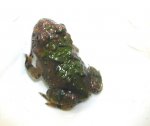caleb
Member
I've raised B. maxima for quite a while now. Metamorphs usually have four green spots on their back (that disappear as they get older). A few of this year's young have bright green over most of their back, as in the attached picture- I've never seen anything like this before.
I had noticed that maxima seem to do much better when they're given plenty of sunlight (artificial light is just not enough), so I went all out this year and raised them outside, against a south-facing wall, in an uncovered tank.
One breeder has told me he had similarly greenish B. variegata kolombatovici metamorphs when raised in a shallow algae-filled pond. Has anyone here had similar results in Bombina (apart from Korean orientalis, obviously)?
I had noticed that maxima seem to do much better when they're given plenty of sunlight (artificial light is just not enough), so I went all out this year and raised them outside, against a south-facing wall, in an uncovered tank.
One breeder has told me he had similarly greenish B. variegata kolombatovici metamorphs when raised in a shallow algae-filled pond. Has anyone here had similar results in Bombina (apart from Korean orientalis, obviously)?

